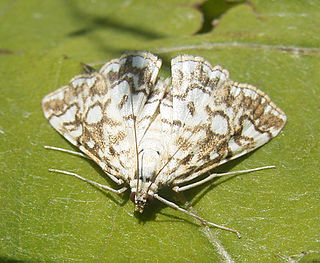
Yanagisawa Yoshiyasu was a Japanese samurai of the Edo period. He was an official in the Tokugawa shogunate and a favourite of the fifth shōgun, Tokugawa Tsunayoshi. His second concubine was Ogimachi Machiko, a writer and scholar from the noble court who wrote monogatari.

Nymphula nitidulata, the beautiful china-mark, is a species of moth of the family Crambidae described by Johann Siegfried Hufnagel in 1767. It is found in Europe, Japan (Hokkaido), Turkey, Armenia, Russia and China.

Musotima is a genus of moths of the family Crambidae.

Anania fuscalis is a species of moth of the family Crambidae. It is found in Europe.
Paracataclysta is a monotypic moth genus in the family Crambidae described by Yutaka Yoshiyasu in 1983. Its single species, Paracataclysta fuscalis, was described by George Hampson in 1893. It is found in South-east Asia, northern Australia and Africa.

Paracymoriza is a genus of moths of the family Crambidae.

Parapoynx is a genus of moths of the family Crambidae described by Jacob Hübner in 1825.

Acentropinae is a fairly small subfamily of the lepidopteran family Crambidae, the crambid snout moths. Species of this subfamily are exclusively found in wetlands and aquatic habitats.
Musotiminae is a subfamily of the lepidopteran family Crambidae. It was described by Edward Meyrick in 1884
Elophila fengwhanalis is a moth in the family Crambidae. It was described by Pryer in 1877. It is found in Japan, China and Korea.

Elophila nigralbalis is a moth in the family Crambidae. It was described by Aristide Caradja in 1925. It is found in Japan, Vietnam, Indonesia and Taiwan.
Elophila orientalis is a moth in the family Crambidae. It was described by Ivan Nikolayevich Filipjev in 1933. It is found in China, Japan and the Russian Far East (Ussuri).
Elophila sinicalis is a moth in the family Crambidae. It was described by George Hampson in 1897. It is found in Japan on Honshu, Kyushu and the Gotō Islands, in China and Korea.
Nymphula corculina is a moth in the family Crambidae. It was described by Arthur Gardiner Butler in 1879. It is found in Japan and the Russian Far East.
Paracymoriza albalis is a moth in the family Crambidae. It was described by Yoshiyasu in 1987. It is found in Thailand.
Paracymoriza multispinea is a moth in the family Crambidae. It was described by Ping You, Shu-Xia Wang and Hou-Hun Li in 2003. It is found in the Chinese provinces of Fujian, Hunan and Guizhou.
Paracymoriza okinawanus is a moth in the family Crambidae. It was described by Yutaka Yoshiyasu and Yutaka Arita in 1992. It is found in Okinawa, Japan.
Potamomusa midas is a moth in the family Crambidae. It was described by Arthur Gardiner Butler in 1881. It is found in Japan, China, the Russian Far East and Korea.
Musotima dryopterisivora is a moth in the family Crambidae. It was described by Yoshiyasu in 1985. It is found in Japan.

Neomusotima fuscolinealis is a moth in the family Crambidae. It was described by Yoshiyasu in 1985. It is found in Japan and Hong Kong. The species was studies as a potential biological control agent for Lygodium japonicum in the United States, but the species was deemed unsuitable since it also fed on the native species Lygodium palmatum.








